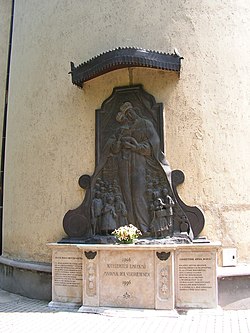Solymár
Solymár
Schaumar | |
|---|---|
UTC+2 (CEST) | |
| Postal code | 2083 |
| Area code | 26 |
Solymár (
History/people
The name of the village is first mentioned in a charter by

The village was uninhabited until the first new settlers arrived around 1700; first

During World War II, Adolf Hitler appealed to ethnic Germans in other countries, no matter how long they had resided there. In some areas, ethnic Germans supported his program, but in many cases had loyalty to where they were living. Because part of the Nazi rationale for war was to unite all ethnic Germans and oppress and exterminate other populations, many eastern European countries, such as Hungary, Poland and the Soviet Union, expelled ethnic Germans after the war. About half the population of Solymár was deported to Germany in 1946 as a collective punishment as part of that massive displacement. More than 330 households in Solymár were vacated.
The empty houses were occupied by ethnic Hungarians relocated from other parts of the country (mainly Mezőkövesd), as well as refugees from Transylvania. In later years, ethnic Hungarians deported from Czechoslovakia arrived. Together with the large-scale migration of people from Budapest in the past decades of suburbanization, ethnic Germans have become a minority of the population. Since 1990 the deportation has been commemorated; a memorial was installed at Templom tér.
Attractions

- Historic Catholic church and other buildings in the village
- Hilltop ruins of a castle
- Budapest War Cemetery[2] contains 173 Commonwealth burials of the Second World War, all of them airmen whose graves were brought in from sites all over Hungary after the war, plus a single First World War burial. The cemetery also contains one French and 37 Polish War Graves.
- On the slope of Zsiros Hill is the opening to the Devil's Hole Cave (Ördöglyuk-barlang), an extensive system approximately 3 kilometres long. It is possible for experienced spelunkers to explore the caves with a guide, but it is not otherwise accessible.
Population
There are 9455 residents, mainly ethnic Hungarians, with a minority of ethnic Germans.
Mayors
- 1990–1994: Péter Dercsényi (Alliance of Free Democrats (SZDSZ))
- 1994–2006: László Enczmann (independent)
- 2006–2010: Kálmán Szente (independent)
- 2010– : Kálmán Szente (FIDESZ-KDNP)
References
- Seres István, "Solymár története és néprajza", Solymár, 1993
